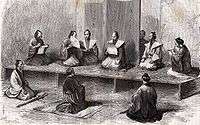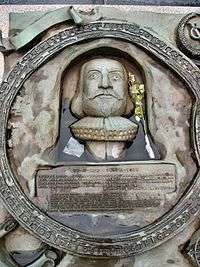List of foreign-born samurai in Japan

This is a list of foreign-born people who became samurai in Japan.
Definition
In this list, Japan means the Japanese archipelago. There are various theories as to the definition of samurai. This list includes the following people.
- Foreign-born people who were "shibun" (ja:士分), soldiers who had the official status of samurai after the establishment of Tokugawa Shogunate.[1][2][3]
- Before the Edo period when classification of shibun had not been established, foreign-born soldiers who were given a territory or rice as salary by their lord as a shibun.
- Foreign-born people who were granted the official post of samurai, for example Hatamoto, Koshō(ja:小姓,[4] page), and Chabōzu(ja:茶坊主,[5] choreman of Daimyō).
- Foreign-born soldiers who were allowed to wear a pair of samurai swords (Daishō) by the lord.[6]
This list excludes the following people.
- Samurai of foreign ancestry born in Japan.
- Foreign-born people who served samurai in other occupations, for example Confucianist or medical doctor.
- Foreign-born people who served samurai as oyatoi gaikokujin, not Japanese-style soldiers.
The following people are treated as "people who could be foreign-born samurai".
- "Foreign-born samurai" whose existence is uncertain.
- Foreign-born people who served samurai, whose occupations were unclear.
- Foreign-born people who were given a territory or rice as salary by lords, whose occupations were unclear.
Foreign-born samurai
| Birthplace | Original name | Occupation before arrival in Japan | Year of arrival in Japan | Name in Japan | Lord | Occupation and achievements in Japan |
|---|---|---|---|---|---|---|
(now |
unknown | Valet of Alessandro Valignano, Italian Jesuit missionary[8][8] | 1579? | Yasuke 弥助[9] |
Oda Nobunaga[9]→ Oda Nobutada[9] |
Retainer who was given salary by Nobunaga.[10] Weapon bearer of Nobunaga.[11] He served in Honnō-ji incident.[9] |
(now |
Kim Yeocheol (Kanji: 金如鉄)[13] |
Son of Imperial Scribe[13] | 1592[12] | Wakita Naokata 脇田直賢[12] |
Maeda Toshinaga→ Maeda Toshitsune[12]→ Maeda Mitsutaka→ Maeda Tsunanori |
Retainer who was given 1000 koku. On-Koshōgashira (Head of pages). Kanazawa machi-bugyō (Commissioner of Kanazawa city) He served in the Summer Campaign of Siege of Osaka.[12] |
(now |
(Kanji:朴好赫 or 朴元赫)[14] | Son of lord of small castle in Gyeonju[14] | Posterior to 1592[14] | Chōjirō 長次郎 or 長治郎→ Akizuki Nagazaemon[15] 秋月長左エ門[14] |
Chōsokabe clan[14] | Page of Chōsokabe. After Chōsokabe clan had been removed from Tosa province, he became renowned Korean style tofu seller.[14] |
| (Kanji:梁夢麟, Romaji:Ryō Murin)[16] | Son of 梁千頃 from Joseon[16] | 1597?[16] | unknown | Wakisaka Yasuharu[16] | Chabōzu of Yasuharu.[16] In 1617, he returned to Joseon.[17] | |
| unknown[18] | Son of 曽清官, commanding officer of Joseon[18] | 1598[18] | Soga Seikan 曽我清官[18] |
Nakagawa Hidenari[18] | Page of Hidenari. Retainer who was given 150 koku.[18] | |
(now |
Jan Joosten van Loodensteyn | Mate of De Liefde, Dutch ship[19] | 1600[20] | Yayousu 耶楊子 |
Tokugawa Ieyasu→ Tokugawa Hidetada |
Hatamoto.[19][21] Under the Tokugawa Shogunate, he chartered several Red Seal Ships. |
| William Adams | Mate of De Liefde, Dutch ship[19] | 1600[20] | Miura Anjin (the pilot of Miura) 三浦按針 |
Tokugawa Ieyasu→ Tokugawa Hidetada |
Hatamoto.[19][22] Retainer who was given 250 koku. Interpreter and shipwright of Tokugawa Shogunate (Adams was the model for the character of John Blackthorne in James Clavell's novel Shōgun (1975)). | |
| John Henry Schnell[23] | Secretary of the Prussian consul Max von Brandt[23] | Prior to 1866[23] | Hiramatsu Buhei 平松武兵衛[24] |
Matsudaira Katamori | Military instructor of Aizu Domain. He procured weapons to for Ōuetsu Reppan Dōmei. He was given right to wear swords.[24] | |
| Eugène Collache | French Navy officer | Prior to 1868[25] | none | Enomoto Takeaki | He fought for Ezo Republic. He served in Battle of Miyako Bay |
People who could be foreign-born samurai
- Foreign-born people who were given a territory.
- Kinkan(金宦)…Attendant of Katō Kiyomasa who was given 200 koku. Born as 良甫鑑 in Joseon, he had served Korean princes until Imjin war. Captured and fascinated by Kiyomasa, he served him in Japan. After Kiyomasa died, he followed to the grave.[26][27]
- Ri Motohiro(Lee Motohiro,李元宥)…Adviser of Mōri clan who was given 100 koku. Born as 李聖賢, he was son of 李福男, blood relative of the royal family of Joseon and governor of Jeolla Province. He was captured during Imjin war, then served Mōri clan as otogishū(adviser).[28]
- Foreign-born people who was given a salary.
- 朴好仁(Japanese: Paku Kōjin, or Park Kōjin)…Father of Akizuki Nagazaemon. After he had run tofu shop with his son, he served Katō Yoshiaki, and then Fukushima Masanori. He was given salary by them. Later, he returned to Joseon.[14]
- Other possible foreign-born samurais
- Yamashina Katsunari (山科勝成)…He was born in Italy, and served Gamō Ujisato as retainer. It is said that Gamō clan sent embassy to Rome with the help of Katsunari. But his existence is highly questioned.[29]
- Kawasaki Seizō(川崎清蔵)…He was born as 達越 in Joseon. His courtesy name was 宗歓. He was castaway from Korean peninsula, and served Nabeshima Naoshige. During Imjin war, he was active from behind as Japanese spy. Later he became merchant, and built town in Saga now called Toujinchō.[30][31]
- Inpuku (允福)…Son of 慎忠義, military officer of Joseon. He was eunuch. Captured during imjin war, he won favor of Tokugawa Ieyasu. He seemed to be page of Ieyasu.[32]
- Okada Hanzaemon(岡田半左エ門)…During imjin war, he was brought up by Mōri Motomasa, and became close adviser of him. But later he was expelled because of fight and injury.[33]
- unknown…Mori Shimanokami, navy officer of Hachisuka clan had retainer born in Joseon.[34]
- Watanabe Kotonori(渡辺士式)…Born as 孟二寛 in Ming Dynasty, he served Asano clan utilizing his medical knowledge.[35] His grandson, Takebayasi Takeshige was member of Forty-seven Ronin.
Other account
"Mimibukuro", essay written in Edo period said refugee from Joseon became gatekeeper of Yagyū clan. He sent his lord Chinese poetry lamenting his misfortune. His lord pitied him, and made him samurai. At 18th century, his descendants still served Yagyū clan.
Related pictures
-

Gyokusen-en, Japanese garden made by Wakita Naokata and his descendants.
-

Woodblock print of William Adams.
-

The trial of Eugène Collache in Edo.From 1878 "Une aventure au Japon"
See also
References
- ↑ "コトバンク 「士分(しぶん)」". Retrieved 2016-01-05.
- ↑ "コトバンク 「徒士(かち)」". Retrieved 2016-01-05.
- ↑ "『武家の生活』、三田村鳶魚、中央公論社、1997年より「足軽」". Retrieved 2016-01-05.
- ↑ "コトバンク 「小姓(こしょう)」". Retrieved 2016-01-05.
- ↑ "コトバンク 「茶坊主(ちゃぼうず)」". Retrieved 2016-01-05.
- ↑ "コトバンク 「苗字帯刀(みょうじたいとう)」". Retrieved 2016-01-05.
- ↑ Histoire Ecclesiastique Des Isles Et Royaumes Du Japon, 第 1 巻、p.444. Retrieved 2013-06-22.
- 1 2 "ジアン・クラッセ、「日本西教史」上巻、太陽堂書店、1925年、384頁". Retrieved 2015-08-04.
- 1 2 3 4 村上直次郎; 柳谷武夫(訳) (2002), イエズス会日本年報 上, 新異国叢書, 雄松堂出版, ISBN 484191000X
- ↑ "松平家忠、「家忠日記」、文科大学史誌叢書第2巻、吉川半七、1897年、54頁". Retrieved 2015-08-04.
- ↑ 『織田信長という歴史 『信長記』の彼方へ』、勉誠出版、2009年、311-312頁。
- 1 2 3 4 5 "笠井純一、「家伝 金(脇田)如鉄自伝[翻刻解説]」、金沢大学教養部論集. 人文科学篇、1990年、一頁" (PDF). Retrieved 2015-08-04.
- 1 2 "笠井純一、「家伝 金(脇田)如鉄自伝[翻刻解説]」、金沢大学教養部論集. 人文科学篇、1990年、7頁" (PDF). Retrieved 2015-08-04.
- 1 2 3 4 5 6 7 8 内藤 雋輔 (1976), 文禄・慶長役における被虜人の研究, 東京大学出版会,746-748頁
- ↑ as tofu seller
- 1 2 3 4 5 6 内藤 雋輔 (1976), 文禄・慶長役における被虜人の研究, 東京大学出版会,101頁
- ↑ 内藤 雋輔 (1976), 文禄・慶長役における被虜人の研究, 東京大学出版会,121頁
- 1 2 3 4 5 6 7 内藤 雋輔 (1976), 文禄・慶長役における被虜人の研究, 東京大学出版会,723-724頁
- 1 2 3 4 "森良和、「メルヒオール・ファン・サントフォールト」、2014年、82頁" (PDF). Retrieved 2015-08-04.
- 1 2 "森良和、「メルヒオール・ファン・サントフォールト」、2014年、81頁" (PDF). Retrieved 2015-08-04.
- ↑ Corr, Adams the Pilot: The Life and Times of Captain William Adams. Pp.158
- ↑ 『家康の家臣団: 天下を取った戦国最強軍団』、山下昌也、学研プラス、2011年
- 1 2 3 "Hirohisa Kawaguchi,HENRY SCHNELL AND JAPANESE IMMIGRATION TO THE UNITED STATES,347頁" (PDF). Retrieved 2015-08-04.
- 1 2 "Hirohisa Kawaguchi,HENRY SCHNELL AND JAPANESE IMMIGRATION TO THE UNITED STATES,348頁" (PDF). Retrieved 2015-08-04.
- ↑ "Une aventure au Japon", by Eugene Collache, p.49
- ↑ "金宦さん之墓". Retrieved 2015-12-04.
- ↑ 内藤 雋輔 (1976), 文禄・慶長役における被虜人の研究, 東京大学出版会,726-725頁
- ↑ "可児弘明、「孟二寛とその後裔」、『史学』 2006、2006年、三田史学会、99頁". Retrieved 2015-08-04.
- ↑ "辻善之助、「海外交通史話」、1930年、内外書籍、450-464頁". Retrieved 2015-08-04.
- ↑ 内藤 雋輔 (1976), 文禄・慶長役における被虜人の研究, 東京大学出版会,734-735頁
- ↑ "40宋歓と唐人町" (PDF). Retrieved 2015-12-03.
- ↑ 内藤 雋輔 (1976), 文禄・慶長役における被虜人の研究, 東京大学出版会,67頁
- ↑ 内藤 雋輔 (1976), 文禄・慶長役における被虜人の研究, 東京大学出版会,759頁
- ↑ 内藤 雋輔 (1976), 文禄・慶長役における被虜人の研究, 東京大学出版会,754頁
- ↑ "可児弘明、「孟二寛とその後裔」、『史学』 2006、2006年、三田史学会、101頁". Retrieved 2015-08-04.
